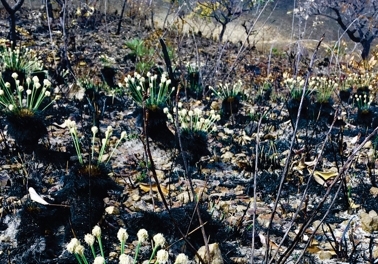


Rapid resprouting and flowering of Bulbostylis paradoxa is proof of the Cerrado biome’s superb resilience and its capacity to evolve through fire (photo: Alessandra Fidelis / personal archive)
Published on 05/13/2021
By José Tadeu Arantes | Agência FAPESP – Plants in the Brazilian savanna, the Cerrado, have evolved to deal with fire. When fire is used intelligently as part of a carefully planned land management method, it is indispensable to the conservation of this superb ecosystem, the world’s most biodiverse savanna. Two months suffice for the Cerrado to burst into flower after a fire (read more at agencia.fapesp.br/26064 and agencia.fapesp.br/26542).
The study “From ashes to flowers: a savanna sedge initiates flowers 24 h after fire”, published recently in the journal Ecology, confirms this observation.
“The species is Bulbostylis paradoxa, a sedge [perennial herb similar to rushes and grasses] belonging to the family Cyperaceae,” Alessandra Fidelis, first author of the article, told Agência FAPESP. “Its common name in Brazil is cabelo-de-índio [‘Amerindian hair’].”
Fidelis is a professor at São Paulo State University (UNESP) in Rio Claro, Brazil, and conducted the study with support from FAPESP as part of the project “How does the fire season affect Cerrado vegetation?”.
The Cerrado is a unique type of savanna. Its capacity to grow back and flower after burning is a key difference in comparison to African and Australian savannas. This had already been reported in the nineteenth and early twentieth centuries by naturalists who visited Brazil, such as French botanist Augustin de Saint-Hilaire (1779-1853) and Danish plant ecologist Eugen Warming (1841-1924). Leopoldo Magno Coutinho (1934-2016), a professor at the University of São Paulo (USP), focused on it in his habilitation. Fidelis has been studying postfire regeneration of the Cerrado since 2009, but in this study, she was struck by the speed with which B. paradoxa flowers after being completely charred in a wildfire. The article is indeed a first in this respect. “It’s the only event of its kind described worldwide to date,” she said.
B. paradoxa is distributed throughout South America and is found from Venezuela to the south of the continent. It flowers on a significant scale only after fires. “In our experiments with burning as a careful management practice, we found that plants of this species reduced to carbonized stumps began exhibiting white spots 24 hours after the fire. These spots were incipient inflorescences,” Fidelis recalled. “In little more than a week, the flowers were fully formed and ready for pollination. The speed of this response is a significant advantage for the plant, enabling it to flower, fructify and disperse windborne seeds in the open, with the soil uncovered and without barriers or competitors. Only 40 days after a fire, it’s very hard to find seeds because they’ve dispersed.”
More generally, the abundant seeds available after fires in the Cerrado are an important resource for predators, such as ants and birds. Resprouting leaves are tender and palatable to large mammals, such as deer and cattle. Burning is a problem when it results from arson or uncontrolled wildfires that spread disastrously owing to a buildup of combustible material after years without properly managed burning.
“The Cerrado has evolved through fire,” Fidelis said. “Its vegetation regenerates easily. Species that did not occur before a fire may appear in certain areas. The animals may suffer losses, however, as many of them are trapped in fires. It is crucial to bear in mind that the Cerrado contains gallery forest, valley forest and palm marshes, where fire-sensitive species may fail to recover after a major burning. Hence, careful fire management is important. Preventive burning at the right time, with total area zoning and a rotating fire schedule for demarcated patches, is the best defense against disasters due to uncontrolled wildfire.”
Expansion of the agricultural frontier, with large-scale monocultures and the intensive use of machinery and herbicides, leaving the soil completely clear and subject to invasion by signalgrass and molasses grass, is currently the main threat to the Cerrado’s survival. Improper use of fire is the next most important threat. Together, these two factors endanger the continued existence of the entire ecosystem. Some of Brazil’s most important rivers originate in the Cerrado, including the Xingu, Tocantins, Araguaia, São Francisco, Parnaíba, Gurupi, Jequitinhonha, Paraná and Paraguay rivers. In addition to the irreparable loss of biodiversity, destruction of the Cerrado jeopardizes the basins of these rivers as a major source of fresh water and hydropower potential.
The other participants in the study in addition to Fidelis were Patrícia Rosalem, Vagner Zanzarini, Liliane Santos de Camargos and Aline Redondo Martins, all affiliated with UNESP.
The article “From ashes to flowers: a savanna sedge initiates flowers 24 h after fire” can be read at esajournals.onlinelibrary.wiley.com/doi/full/10.1002/ecy.2648.
Source: https://agencia.fapesp.br/30341